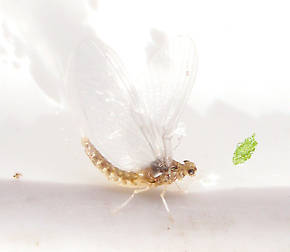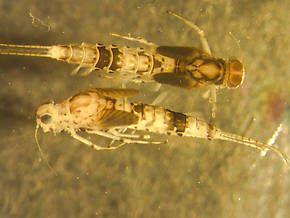Blog & Latest Updates
Fly Fishing Articles
Insects by Common Name


Mayfly Genus Anafroptilum (Tiny Sulphur Duns)
Taxonomic Navigation -?-
Kingdom
Animalia (Animals)
» Phylum
Arthropoda (Arthropods)
» Class
Insecta (Insects)
» Order
Ephemeroptera (Mayflies)
» Family
Baetidae (Blue-Winged Olives)
» Genus Anafroptilum (Tiny Sulphur Duns)
| Species in Anafroptilum | ||
| Anafroptilum albumTiny Sulphur Dun | 0 | 0 |
| Anafroptilum asperatumTiny Sulphur Dun | 0 | 0 |
| Anafroptilum bifurcatumTiny Sulphur Dun | 0 | 0 |
| Anafroptilum conturbatumTiny Sulphur Dun | 0 | 0 |
4 species aren't included.
Common Names
| Match | Common Name |
| Tiny Sulphur Duns | |
| Spurwings | |
| Pale Watery Duns |
They are closely related to the important European "Spur Wings", a name given them due to the hook on the leading edge of their hind wings. These very small mayflies are usually reported in this country as inhabiting water too warm and/or stagnant for trout but this is not always the case. Significant numbers have been reported in many cold water environments throughout the West. These tiny sulphurish mayflies are easy to confuse with small Pale Morning Duns which is perhaps the reason for their under-reporting by anglers. Their having only two tails is the easiest to way to tell the difference.
From an angling perspective, a downside of many taxonomic advances is the loss of what was thought to be the ability to use easily identifiable morphological differences for determining between genera. This is especially problematic in sorting out baetids. The truth is the old rule used by anglers involving the hindwings (i.e., spurwing - prev. Centroptilum, no wing - prev. Pseudocloeon, the rest - Baetis) has been dubious for years. They can no longer be applied as more has been learned about new genera and species properly reassigned. It is now recognized that some species of Anafroptilum and Baetis lack hindwings altogether.
Hatching Behavior
In cold water environments, Anafroptilum mayflies have been reported to emerge in typical baetid fashion. In warmwater, reporting suggests crawling out onto shore to hatch making the duns unimportant, though this fact is irrelevant as warm water precludes trout anyway.
Spinner Behavior
The duns molt into spinners the same day they emerge, and they fall spent (Spent: The wing position of many aquatic insects when they fall on the water after mating. The wings of both sides lay flat on the water. The word may be used to describe insects with their wings in that position, as well as the position itself.) right next to the bank after mating. But again this is warmwater behavior and does not translate to cold water environments where they are reported to fall to the surface in open currents.
Pictures of 2 Mayfly Specimens in the Genus Anafroptilum:
Female Anafroptilum album (Tiny Sulphur Dun) Mayfly Dun View 3 PicturesApprox. 5 mm. This is a very significant hatch. It is mostly seen at the height of Summer and I was very surprised to see it emerging this late in the season and in such numbers. When this one is emerging, the fish can become quite selective.
View 3 PicturesApprox. 5 mm. This is a very significant hatch. It is mostly seen at the height of Summer and I was very surprised to see it emerging this late in the season and in such numbers. When this one is emerging, the fish can become quite selective.
 View 3 PicturesApprox. 5 mm. This is a very significant hatch. It is mostly seen at the height of Summer and I was very surprised to see it emerging this late in the season and in such numbers. When this one is emerging, the fish can become quite selective.
View 3 PicturesApprox. 5 mm. This is a very significant hatch. It is mostly seen at the height of Summer and I was very surprised to see it emerging this late in the season and in such numbers. When this one is emerging, the fish can become quite selective.Collected November 9, 2011 from the Fall River in California
Added to Troutnut.com by Entoman on December 10, 2011
Added to Troutnut.com by Entoman on December 10, 2011
Anafroptilum conturbatum (Tiny Sulphur Dun) Mayfly Nymph View 2 PicturesA moderately rare mayfly perhaps because the nymphs are fragile that nymphs are usually damaged in collection making identification more difficult.
View 2 PicturesA moderately rare mayfly perhaps because the nymphs are fragile that nymphs are usually damaged in collection making identification more difficult.
 View 2 PicturesA moderately rare mayfly perhaps because the nymphs are fragile that nymphs are usually damaged in collection making identification more difficult.
View 2 PicturesA moderately rare mayfly perhaps because the nymphs are fragile that nymphs are usually damaged in collection making identification more difficult.Collected July 12, 2007 from Bowman Lake in Montana
Added to Troutnut.com by Bnewell on June 26, 2011
Added to Troutnut.com by Bnewell on June 26, 2011
Recent Discussions of Anafroptilum
Centroptilum?
Posted by Entoman on Jan 29, 2011
These are the little creamy guys that hatch profusely on Fall River (CA), causing VERY selective feeding midday at the end of June/early July below the public access. Common name locally is Tiny PMD's which is a misnomer as these are NOT ephemerellids but rather baetids. Their sulfur coloration is what causes the confusion. Fall river runs well under 60 degrees during the Summer so I have my doubts that this (these) genus (genera) is (are) exclusive to warm water. Ernest Schwiebert identifies them when fishing the Paradise Valley spring creeks of Montana with Joe Brooks in one of his books. Makes one wonder if the fairly common reports of PMD's sized 20 and under on our Western spring creeks aren't really talking about this tiny critter.
In England, their olivaceous and larger cousins go by the name "Spur Wing" in honor of the rear projecting spike off the leading edge of the hind wing. They are reported as important hatches. This spur used to be the easiest identifying characteristic separating species of Centroptilum from others in the Baetidae family. Though the generic name has not been done away with, many species of possible importance to fishermen have been scattered among several genera (at least for now) and new ones added where this unique wing feature is not shared, thus making stream side identification beyond the familial virtually impossible. The only thing that can be known for sure is that species that fit the above description used to be called Centroptilum, so my comments on this hatch are listed here.
ReplyIn England, their olivaceous and larger cousins go by the name "Spur Wing" in honor of the rear projecting spike off the leading edge of the hind wing. They are reported as important hatches. This spur used to be the easiest identifying characteristic separating species of Centroptilum from others in the Baetidae family. Though the generic name has not been done away with, many species of possible importance to fishermen have been scattered among several genera (at least for now) and new ones added where this unique wing feature is not shared, thus making stream side identification beyond the familial virtually impossible. The only thing that can be known for sure is that species that fit the above description used to be called Centroptilum, so my comments on this hatch are listed here.
Your Thoughts On Anafroptilum:
Top 10 Fly Hatches
Top Gift Shop Designs
Eat mayflies.
Top Insect Specimens
Miscellaneous Sites
Troutnut.com is copyright © 2004-2024 Jason
Neuswanger (email Jason). See my FAQ for information about use of my images.
 privacy policy
privacy policy
